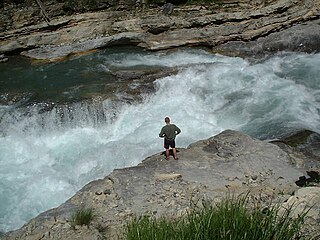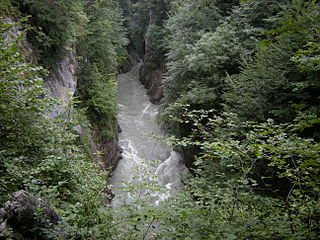Related Research Articles

Whitewater forms in the context of rapids, in particular, when a river's gradient changes enough to generate so much turbulence that air is trapped within the water. This forms an unstable current that froths, making the water appear opaque and white.

Whitewater kayaking is an adventure sport where a river is navigated in a decked kayak. Whitewater kayaking includes several styles. River running; where the paddler follows a river and paddles rapids as they travel. Creeking usually involving smaller, steeper, and more technical waterways. Creek boats tend to be short but high volume to allow for manoeuvrability while maintaining buoyancy. Slalom requires paddlers to navigate through "gates". Slalom is the only whitewater event to be in the Olympics. Play boating involves staying on one feature of the river and is more artistic than the others. Squirt boating uses low-volume boats to perform special moves in whitewater features.

Canoe slalom is a competitive sport with the aim to navigate a decked canoe or kayak through a course of hanging downstream or upstream gates on river rapids in the fastest time possible. It is one of the two kayak and canoeing disciplines at the Summer Olympics, and is referred to by the International Olympic Committee (IOC) as Canoe/Kayak Slalom. The other Olympic canoeing discipline is canoe sprint. Wildwater canoeing is a non-Olympic paddlesport.

Dudh Koshi is a river in eastern Nepal. It is the highest river in terms of elevation.

The Yarlung Tsangpo Grand Canyon, also known as the Yarlung Zangbo Grand Canyon, the Tsangpo Canyon, the Brahmaputra Canyon or the Tsangpo Gorge, is a canyon along the Yarlung Tsangpo River in Tibet Autonomous Region, China. It is the deepest canyon in the world, and at 504.6 kilometres (313.5 mi) is slightly longer than the Grand Canyon in the United States, making it one of the world's largest. The Yarlung Tsangpo originates near Mount Kailash and runs east for about 1,700 kilometres (1,100 mi), draining a northern section of the Himalayas before it enters the gorge just downstream of Pei, Tibet, near the settlement of Zhibe. The canyon has a length of about 240 kilometres (150 mi) as the gorge bends around Mount Namcha Barwa and cuts its way through the eastern Himalayas. Its waters drop from about 2,900 metres (9,500 ft) near Pei to about 1,500 metres (4,900 ft) at the end of the Upper Gorge where the Po Tsangpo River enters. The river continues through the Lower Gorge to the Indian border at an elevation of 660 metres (2,170 ft). The river then enters Arunachal Pradesh and eventually becomes the Brahmaputra.

Gore Canyon, elevation 6,985 feet (2,129 m), is a short isolated canyon on the upper Colorado River in southwestern Grand County, Colorado in the United States. Steep and rugged, the approximately 3-mile-long (4.8 km) gorge was carved by the river as it passed the northern end of the Gore Range southwest of Kremmling. The Colorado descends from approximately 7,300 ft (2,200 m) to approximately 7,000 ft (2,100 m) over the length of the canyon. The steep walls ascend approximately 1,000 ft (300 m) on either side. The canyon effectively marks the southwestern end of the Middle Park basin in north-central Colorado.
Mike Jones QGM was a 20th-century canoeist, best known for his expeditions on the Blue Nile and Dudh Kosi.
Bruce Kirkby is a Canadian adventurer, photographer, and writer. Recognized for expeditions to remote wilderness areas, his achievements include a 40-day, 1000-kilometre crossing of Arabia's Empty Quarter by camel (1999) and the first contiguous descent of Ethiopia's Blue Nile Gorge from source to the Sudanese border. The author of three best-selling books, Kirkby's writing has appeared in numerous publications, including The Globe and Mail, Canadian Geographic and The New York Times. National Geographic Channel featured his photography in the documentary Through the Lens (2003). An Ambassador for Mountain Equipment Co-op and member of the Starboard SUP Dream Team, Kirkby makes his home in Kimberley, British Columbia.

The Yarlung Tsangpo, also called Yarlung Zangbo and Yalu Zangbu River is the upper stream of the Brahmaputra River located in the Tibet Autonomous Region, China. It is the longest river of Tibet and the fifth longest in China. The upper section is also called Dangque Zangbu meaning "Horse River."

The Grand Canyon of the Stikine is a 72 km (45 mi) stretch of the Stikine River in northern British Columbia, Canada. It has been compared to the Grand Canyon of the Colorado. The canyon is home to a large population of mountain goats and other wildlife. Officially the canyon is described as unnavigable by any watercraft, however there have been numerous successful descents made by expert whitewater paddlers since the first attempt in 1981. Since it was first attempted, the Grand Canyon of the Stikine has maintained a legendary reputation among whitewater experts as the 'Mt. Everest' of big water expedition whitewater boating against which all other navigable rivers are measured.
Douglas Cameron Gordon, commonly known as Doug Gordon, was an American whitewater kayaker, who was a member of the U.S. Slalom Team from 1981 to 1987, and a chemist. Gordon died in Eastern Tibet when he and three other paddlers attempted the first descent of the Tsangpo River.
James Patrick McEwan was an American slalom canoeist who competed in the 1970s and then again in the 1980s and early 1990s. He teamed up with his son Devin to compete in the 2000s. Competing in two Summer Olympics, he won a bronze medal in the C1 event at Munich in 1972.
Tyler Bradt is an American whitewater kayaker known for kayaking Palouse Falls.
Wickliffe Wade Walker, also called Wick Walker, is an American slalom canoeist, whitewater explorer, soldier, and author. He represented the US in the World Championships of 1965, 1967, and 1971, and he was US National Champion in Men's C-1 Slalom in 1968. He finished 11th in the C-1 event at the 1972 Summer Olympics in Munich.

The Boonton Gorge is a river gorge in Boonton, New Jersey where the Rockaway River drops over several waterfalls, and travels for slightly over a mile before emptying into the Jersey City Reservoir.

Canoeing – recreational boating activity or paddle sport in which you kneel or sit facing forward in an open or closed-decked canoe, and propel yourself with a single-bladed paddle, under your own power.
Doug Ammons is an adventurer and is best known for his kayaking expeditions. He has degrees in mathematics, physics, and a masters and PhD in psychology from University of Montana. He is also a classical guitarist, black-belt martial artist, an author, philosopher and worked for many years as an editor for two academic journals of psychology Psychological Reports and Perceptual and Motor Skills.

Salzachöfen, sometimes translated as Salzachöfen Gorge, is a narrow gorge in the Northern Limestone Alps of Salzburg State, Austria. The gap is formed by the Salzach river as it cuts between the Hagen Mountains and Tennen Mountains. Lueg Pass provides a route along the Salzach above Salzachöfen. The terms Lueg Pass and Salzachöfen are sometimes used interchangeably to refer to the whole canyon.
Benny Marr known as Ben is a Canadian professional extreme whitewater kayaker and 2018 rider of the year. As a part of the Grand Inga Project team, he was a recipient of the 2013 National Geographic Adventurers of the Year award. Other extreme kayaking projects include a one day descent of the Stikine River in British Columbia, and kayaking expedition to Papua New Guinea with Ben Stookesberry, Chris Korbulic and Pedro Leiva for the first descent of the Beriman Gorge.
References
- ↑ "Taking On Great Falls Rapids". www.connectionnewspapers.com. Retrieved January 29, 2020.
- ↑ Berman, Tao (March 12, 2010). Going Vertical: The Life of an Extreme Kayaker. Menasha Ridge Press. p. 230. ISBN 978-0-89732-776-3.
- ↑ Hunter, Brad (September 24, 2000). "SHOOTING THE RAPIDS IN SHANGRI-LA". New York Post. Retrieved January 29, 2020.
- ↑ Phillips, Angus (October 31, 1998). "Tibet Kayak Expedition Turns Fatal". Washington Post. Retrieved January 29, 2020.
- ↑ Ault, Alicia (May 14, 2004). "JOURNEYS; Adventurer | Whitewater Kayaking". The New York Times. ISSN 0362-4331 . Retrieved January 29, 2020.